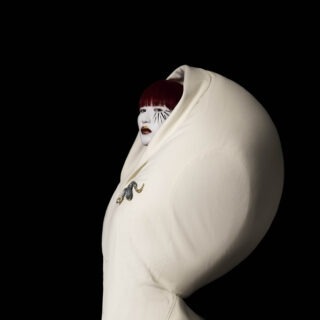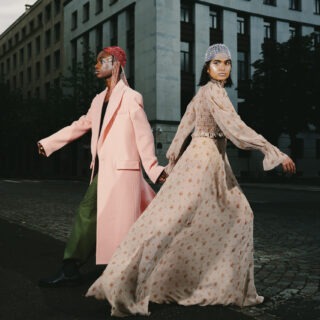words: Metaverse Academy: Martha Boeckenfeld
digital illustration. Anya Biarozka
issue 1 – in love with Switzerland
“The smartphone is no longer just a device that we use,” says Daniel Miller, professor of anthropology at University College London. “It’s become the place where we live.”
It’s only one more step to get into the world beyond the Universe- the Metaverse. The word itself is a combination of ‘Meta’, the Greek prefix for beyond, across or after, and universe. In this sense, we can simply understand the metaverse as the evolution of the internet where digital and physical converge. With Facebook rebranding itself to Meta in October last year, the Term Metaverse was shut into the global media world and the spike and intensive search on Google indicated the next big hype with an estimated growth opportunity by 2030 of $5Trillion (McKinsey). Although the term dates back to 1992: the American sci-fi writer Neal Stephenson first coined the term metaverse in his book Snow Crash, which depicts dystopian future world where rich people escape into an alternative 3D, connected reality.
Dystopia or Utopia?
Rather than the dystopian view of a new world, we need to think of the metaverse as «an evolution of the internet that enables us to move beyond browsing to inhabiting and/or participating in a persistent shared experience that spans the spectrum of our real world to the fully virtual and in between- interconnected virtual and real worlds where people can socialize, work, transact, play, and create together in new ways- breaking physical barriers and creating value for our society.» (inspired by Matthew Ball)
Especially while understanding that the metaverse is not a finished state or a discrete technology, but looking at it as an evolution of a set of possibilities for how we will live our lifes, the metaverse is the bridge to the unseen world. It allows people to directly communicate and visualize things that were previously very difficult, such as their imagination. There will be many individual metaverses as well as platforms for building metaverses like the Meta metaverse which will also require languages for describing metaverse specific transformations. Other specialized metaverse browsers will be needed to show the way forward.
Desire Or Reality?
What we consider as “The Metaverse”, a space where the real and the virtual world converges, where we can move freely between different virtual worlds does not exist yet. Before we reach such an advanced level of VR (Virtual Reality), we must first work on the following: hardware, infrastructure, interoperability, and content. The amount of data that the entire infrastructure should be able to manage for the real-time rendering of objects, avatars, and environments is impressive. We are not talking about a video game – difficult, but manageable by the computational power of the machines and servers we have now. Interoperability is currently the mother of all challenges. The main problem is that there are no shared standards among the various potential actors of the metaverse.
By interoperability, we mean the possibility that content produced on a platform can then be used, displayed and shared on others. Take a photo used at Facebook-you can download it and then use it on Snapchat or upload it to a site that provides this possibility. This is possible because Facebook has the option to download the photo and because there are standard photo formats that are accepted everywhere. Just imagine how much more complex it is for a 3D file like those that are used and should be exchanged in the metaverse. And this is both because of the larger size of the files themselves, and because there is still no shared standard.
One last illusion is content. Lack of content is of the main obstacles to the mass adoption of spatial computing. The end user, however, expects to find available and customizable apps, for their specific field. With every technological step, we are getting closer to this new world.
«The world will never look the same,» Joel Dietz, a cyberfuturist, artist and entrepreneur, concludes.
Even if the Metaverse in its entirety might be a decade away, on our journey into the Metaverse, we are already changing our expectations and experiences, with every part of our lifes transitioning into an exciting era of endless possibilities. How can we master this new World of Imagination, where everything is possible and feels real?
Me, MySelf and My Avatar
Do you want to be a unicorn?
To act in the metaverse, you need to authenticate yourself. As a virtual representation of yourself, you can choose whatever you want to be. If you ever dreamt of being a unicorn or having wings, an avatar can bring these imaginations to life. An avatar, which is more a reflection of the user and the personal identity creates a sense of authenticity in online interactions and is used to convey information about the user’s personality, interests, and values. A user might choose to create an avatar that looks fashionable, sporty, or artistic to signal their personal style and interests to others. In 2022 alone, more than 11.5 million creators designed over 62 million virtual clothing and accessory items on Roblox. These creators dress millions of people all over the world and impact how they express themselves both in the digital and physical worlds.
To put that in context, there are at least 200 times as many creators designing clothing and accessories on Roblox as the estimated number of fashion designers creating physical collections in the United States. In 2022, we’ve seen a large influx of global fashion and beauty brands creating digital fashion and immersive experiences for Roblox (or integrating with existing popular experiences on the platform) – including Gucci, Burberry, Carolina Herrera, Tommy Hilfiger, NARS, Alo Yoga and supermodel and entrepreneur Karlie Kloss, as well as metaverse-only fashion companies like DRESSX. Most of these brands are tapping into the vast expertise of Roblox community members who can help create beautiful digital fashion and other engaging content on the platform.
“Fashion Designer in the Future won’t just be sewing, they’ll be coding“, believes Karlie Kloss Supermodel and Entrepreneur.
© Schön! Switzerland. All rights reserved.






